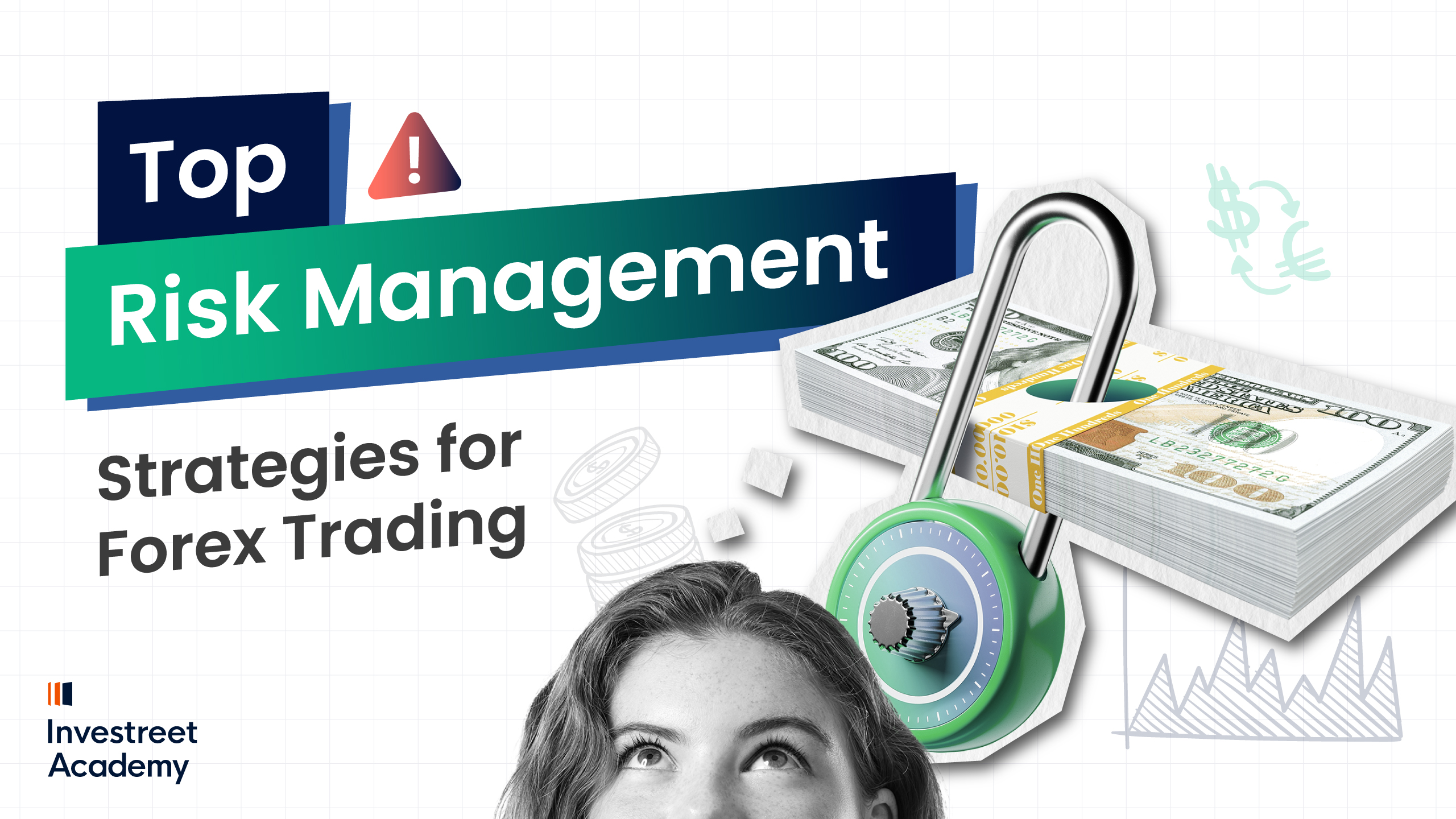The forex market is the most active and liquid in the world, with trillions of dollars changing hands between different currencies daily. While it provides numerous trading opportunities, it also carries several types of risks that require a risk management plan. In this article, we will define risk management, explore the significant risks that forex traders might face, such as leverage risk and volatility risk, among others, and finally, provide steps to follow for managing risk efficiently.
What is Risk Management in Trading?
Risk management in trading is the process of identifying potential downsides and taking actions to mitigate losses while trading. This process involves several strategies, using different risk management tools to limit the impact of market movements risk, among others, on the trader’s portfolio. The main goal is to protect your trading capital and ensure long-term trading success.
After defining the core concept of risk management, let’s take a closer look at the specific risks that a forex trader might face.
What are the significant risks that a Forex trader faces?
Developing a trading risk management plan requires a full understanding of the potential risks that may arise during your trading journey.
- Leverage Risk:
The leverage allows traders to control a larger position in the market with a relatively smaller amount of capital, which magnifies the potential gains, but it can also magnify losses. The primary risk is that losses can rapidly exceed the initial margin, and the trader may face a margin call, requiring them to deposit more funds to cover the losses or face liquidation.
- Volatility Risk:
Volatility risk refers to the potential for unexpected and rapid price fluctuations in currency exchange rates. It’s the degree of price fluctuations of a currency pair over a given time, how much and how quickly the exchange rate changes. The price changes due to various factors such as economic news, political events, market sentiment, and natural disasters.
Market volatility differs from one currency pair to another. Some currency pairs are known for their high volatility, while others are less volatile. Being familiar with which currency pairs are volatile, it’s essential to avoid the risk of unexpected movements and fluctuations.
- Liquidity Risk:
A currency pair is considered highly liquid when it can be easily bought or sold without causing a significant price change, and when many active buyers and sellers are trading it.
The liquidity risk arises when fewer participants are trading a specific currency pair, making it less liquid. This typically occurs during certain times of the day, such as late at night, on market holidays, or with less popular currency pairs.
Lower liquidity can lead to slippage, which means that your order may not be executed at the expected price in response to a lack of buyers at that level, resulting in a less favorable execution.
- Interest Rate Risk:
In forex trading, interest rate risk refers to the probability that a currency pair will decline in value due to unexpected changes in interest rates set by central banks. Interest rates are a key driver of exchange rates, as they can significantly influence the attractiveness of currency to foreign investors.
- When a country’s central bank raises its interest rates, this typically attracts foreign investors seeking higher returns, leading to increased demand and strengthening the currency.
- Conversely, if a country lowers its interest rates, the currency becomes less attractive to investors, potentially decreasing demand and weakening it.
If the U.S. Federal Reserve raises interest rates unexpectedly, while the Bank of Japan has lower rates. Many investors may convert capital into U.S. dollars to take advantage of the higher returns. This will increase demand for USD and strengthen the USD/JPY exchange rate, thereby pushing the USD/JPY pair higher.
However, if the Fed lowers interest rates unexpectedly, the USD weakens, and the USD/JPY pair will then decline.
- Geopolitical Risk:
Geopolitical events can trigger volatility in currency markets because traders react to increased risk and uncertainty. Geopolitical risks and uncertainty can influence the value of currency pairs and the overall foreign exchange market. Forex traders must closely monitor geopolitical events and assess their potential impact.
For instance, during periods of geopolitical tensions, the “flight to safety” behavior tends to increase, causing the currencies of nations involved in uncertainty to weaken while safe-haven currencies like the US dollar or Swiss franc strengthen.
- Economic Data Risk:
Economic data risk refers to the high volatility of a currency pair caused by the release of a significant economic indicator. Data, such as GDP growth, employment reports, inflation rates, or central bank reports, can influence market sentiment, causing volatile movements.
The risk arises when the actual economic data deviates significantly from market expectations, prompting the currency pair to react immediately. Traders must monitor the major economic indicators and scheduled announcements to be prepared for potential volatility.

For instance, EUR/USD, when the U.S. non-farm payroll (NFP) number is released, shows much stronger job growth than expected, which is a positive signal for a strong U.S. economy.
A strong U.S. economy may increase the likelihood of the Federal Reserve raising rates, which would strengthen the U.S. dollar, causing a downward trend for EUR/USD.
On the other hand, if a weaker-than-expected NFP report is released, it could weaken the USD, and the EUR/USD pair would move higher.
- Psychological Risk:
Psychological risk refers to the impact of emotions and mental biases on a trader’s decision-making, which potentially leads to negative trading outcomes. Emotional trading often leads traders to deviate from their trading strategy, neglect proper risks, and result in losses. Emotions such as fear, greed, overconfidence, and cognitive biases can lead to irrational trading decisions.
Now that you’ve explored the potential risks that may arise during your trading journey, it’s time to take a look at the steps you can take to manage risk effectively.
4 Simple Steps to Manage Risk Efficiently while Trading:
For effective risk management, several key elements should be considered to ensure long-term trading success and make informed trading decisions.
Risk tolerance:
Risk tolerance refers to the extent to which you are okay with the idea of losing money in the short term to earn a higher return with your investment over the long run. Your risk tolerance is your willingness to accept short-term losses, aiming to make larger long-term gains. Determining your risk tolerance is a key step to managing risk efficiently.
Many traders struggle with how to determine their risk tolerance when trading forex. A good rule of thumb is to risk between 1-5% of your account balance per trade. Even 5% can be challenging if you experience losses or the market moves against you. Therefore, it’s essential to continuously monitor this percentage based on your open positions and how your trades are performing.
Position Sizing:
Position sizing is the process of determining how much currency to buy or sell in a trade. It is closely related to your risk tolerance, and it cannot be separated from it, as position size is determined based on the percentage of your capital you are willing to risk per trade. Proper position sizing can limit potential losses by controlling the amount of capital exposed to a single trade.
For example, you are trading the EUR/USD pair, account size $10,000, risk per trade 2%, pip value $10 per standard lot. And stop loss 50 pips.
To calculate position size in lots, you need to divide the risk per trade (200) by the stop loss in pips multiplied by the pip value per lot. Position size= 200/(50×10)=0.4 lots.
The position size should be 0.4 lots, which means you risk no more than $200 on this trade.
Stop Loss order:
The stop loss order is an automated exit order that limits potential losses by closing the trading position once the price reaches a predetermined price level. The stop loss level is determined based on your position size and risk per trade.
Determining the stop loss level should be relative to the reward you are seeking. In case you anticipate that the return from a specific trade would be 300 points, and your stop loss is 100 points. This means that your risk-to-reward is healthy with good protection from potential losses. Because losing three trades in a row, it could be made up by only one winning trade of 300 points.
Take profit order:
The take-profit order is an automated order that protects your gains by closing the trading position once your predetermined level is reached. The main purpose of this order is to secure profits before market reversals occur.
For example, if you went long on EUR/USD at 1.1600 and set your TP order at 1.1650. Once the price reaches this level, your take-profit will be triggered and the trade will be closed.
A take-profit order is vital for risk management because it secures your profits before possible market reversals, reduces emotional trading by stopping you from holding onto a trade for too long in the hope of bigger gains, and enhances time efficiency since you can oversee multiple trades at once.
The Bottom Line:
Risk management is important for long-term success in forex trading. While there are many opportunities, there is also risk, so you need to use the right tools and strategies to protect your capital.
By understanding and using risk management tools, setting stop losses, determining position size based on account risk, and being aware of your own psychological and emotional limits, you can trade with more confidence and discipline.
Risk can’t be eliminated, but it can be controlled. With a plan and consistent risk management, you can stay in the market and achieve long-term growth in your trading.





